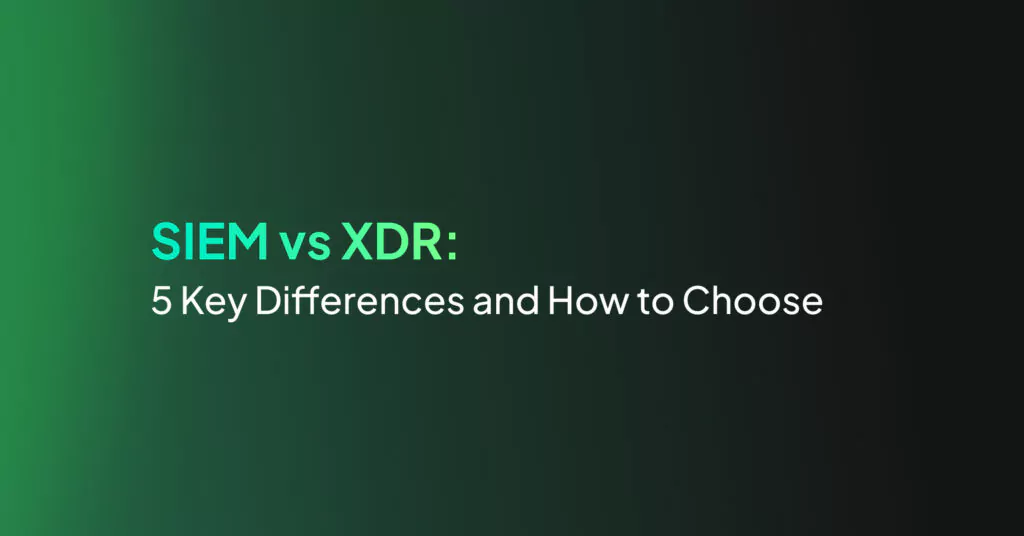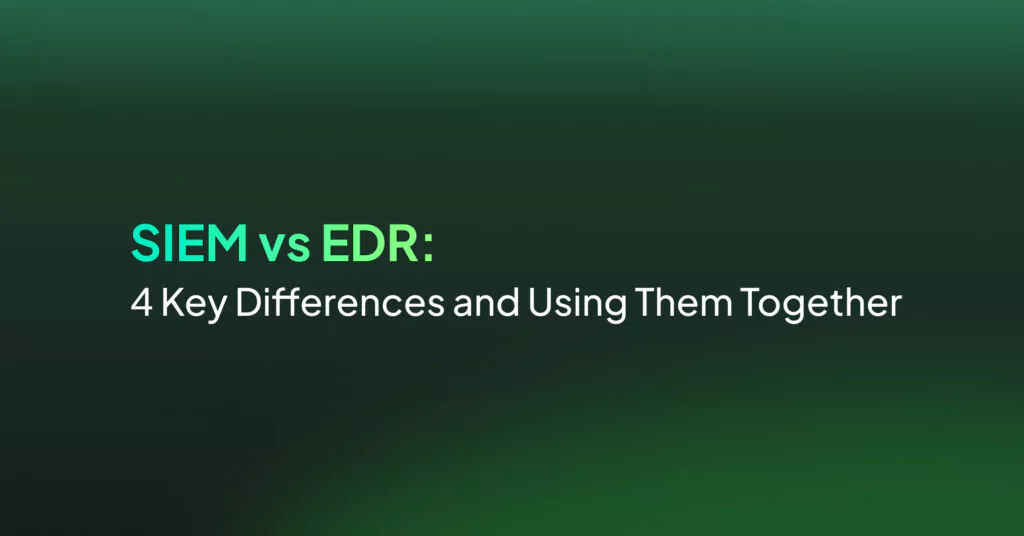What Is Managed Detection and Response (MDR)?

What Challenges Does MDR Address?
MDR services evolved in response to several critical security challenges faced by many organizations.
Evolving Threat Landscape
The threat landscape is constantly evolving, with new types of attacks emerging all the time. Traditional security measures are often unable to keep up with these changes, and organizations often do not have the resources or expertise to use cutting-edge tools, leaving them vulnerable to attack.
MDR services address this challenge by offering continuous monitoring and proactive threat hunting, with access to the latest in security technology. This allows them to detect new and emerging threats quickly and respond effectively.
Limited Resources
Many organizations have limited resources to devote to cybersecurity, both in terms of manpower, available expertise, and the ability to purchase and maintain security infrastructure. This can make it difficult for them to effectively detect and respond to threats.
MDR services address this challenge by providing a team of experienced security analysts, with access to advanced security tooling, who can monitor the organization’s network and systems, analyze security incidents, and respond to threats effectively.
Alert Fatigue
Alert fatigue is a common problem in cybersecurity. Organizations often receive a large number of security alerts, many of which turn out to be false positives. This can lead to alert fatigue, where important alerts are overlooked due to the sheer volume of alerts.
MDR services address this challenge by offering alert triage, which means MDR security experts are responsible for reviewing alerts and prioritizing them based on severity and potential impact. This relieves the load from in-house IT and security teams, and ensures that the most serious threats are addressed first.
Managed Detection and Response Service Features
Incident Investigation
Incident investigation involves carrying out a detailed analysis of potential security incidents to determine their scope, impact, and cause.
When an incident is detected, the MDR service collects and analyzes data from various sources, including network traffic, log files, and endpoint data, to get a complete understanding of the incident. This analysis is critical in identifying the threat actor, understanding their tactics, techniques, and procedures (TTPs), and determining the extent of the damage.
By providing a thorough incident investigation, an MDR service can help organizations understand what happened during a security incident, what vulnerabilities were exploited, and what actions need to be taken to prevent similar incidents in the future.
Alert Triage
Alert triage involves prioritizing security alerts based on their severity and potential impact. Alert triage is essential because organizations often face a barrage of security alerts, not all of which are critical.
By prioritizing these alerts, an MDR service can ensure that the most serious threats are addressed first, reducing the risk of a major security incident. This also reduces the need for in-house staff to review large volumes of alerts from security tools, which leads to alert fatigue and reduced incident readiness.
Remediation
Remediation is a critical feature of an MDR service. This involves taking action to mitigate the impact of a security incident and prevent further damage.
In the event of a confirmed security incident, security professionals at the MDR provider take swift action to contain the threat and eliminate it from the network. This could involve isolating affected systems, blocking malicious IP addresses, or implementing other countermeasures.
Proactive Threat Hunting
Proactive threat hunting is a key feature of MDR services. This involves actively searching for threats that may have bypassed initial security defenses.
By leveraging advanced threat intelligence, analytics tools, and human expertise, MDR security experts can detect advanced threats that traditional security measures might miss. This proactive approach can significantly improve an organization’s ability to detect and respond to advanced threats.
MDR Services vs. Other Security Solutions
MDR vs. EDR
Endpoint Detection and Response (EDR) solutions are designed to monitor and collect data from endpoints like employee workstations or servers. They can detect threats and initiate responses to eliminate them. However, EDR solutions are limited in scope, only addressing threats to endpoints, and require security expertise to operate.
Managed detection and response not only detects and responds to endpoint threats but also addresses other aspects of the IT environment. In addition, MDR services are run by teams of expert security analysts who actively monitor your network, analyze the data, identify threats, and respond accordingly. Many MDR services include EDR technology as part of their offering, but EDR is fully managed by the MDR provider’s security experts.
MDR vs. XDR
Extended Detection and Response (XDR) is considered the evolution of EDR. It aims to provide a holistic view of the threat landscape by integrating multiple security products into a unified platform, addressing threats originating from endpoints, cloud platforms, email systems, networks, and more. However, XDR still requires a high degree of manual intervention and expertise to manage, interpret, and respond to the data it collects.
Many managed detection and response services provide XDR solutions, but combine them with human expertise. MDR providers have teams of cybersecurity experts who operate XDR solutions, interpret the data they provide, and take action when necessary. This takes the burden off internal teams, and enables organizations to utilize XDR even if they don’t have an experienced in-house security team.
MDR vs. MSSP
Managed security service providers (MSSPs) are a service solution for businesses looking to outsource their cybersecurity needs. MSSPs typically provide a wide range of security services, including firewall management, intrusion detection, and vulnerability scanning.
However, where MSSPs often fall short is in their ability to provide a proactive response to threats. Most MSSPs operate on a reactive basis, responding to alerts as they arise. In contrast, Managed Detection and Response services are designed to be proactive, actively hunting for threats and responding to them in real-time. This proactive approach can significantly reduce the time it takes to detect and respond to threats, minimizing the potential damage.
MDR vs. Managed SIEM
Security Information and Event Management (SIEM) solutions are another commonly used cybersecurity tool. SIEMs collect and analyze data from across your network, identifying potential security events and sending alerts when suspicious activity is detected.
While SIEMs can provide valuable insights into your security landscape, they are not a complete solution. SIEMs require a high degree of expertise to manage and interpret the data they collect, and they typically do not provide response capabilities. MDR services not only collect and analyze data but also provide a proactive response to threats.
How to Choose an MDR Service Provider
Here are a few important elements you should evaluate when selecting an MDR provider:
- Level of expertise of MDR analysts: A key aspect of MDR providers is the level of expertise of the analysts operating the service. When evaluating the expertise of analysts, look at their qualifications, certifications, and experience in your industry or relevant use cases.
- How the MDR provider communicates with your team: It is not enough for the provider to detect and respond to threats; they must also effectively communicate their findings and actions to your team. The provider should be open to two-way communication, enabling your team to consult with MDR experts on security issues.
- Composition of MDR team: A larger MDR team can often provide a higher level of service, as there are more people to monitor threats, analyze data, and respond to incidents. The team’s composition is also important—it should include a mix of security analysts, threat intelligence experts, and incident responders.
- 24/7 coverage: Ensure the MDR provider is able to offer 24/7 coverage. This means having a team of analysts working around the clock to monitor your systems for threats. These analysts should be supported by advanced technologies that can automate some aspects of threat detection.
- Average time to detect and respond: The quicker a threat can be identified and addressed, the less damage it can cause. The provider should be able to demonstrate a track record of quick detection and response times. As a rule of thumb, the provider should aim to detect threats within minutes and respond within hours.
- Built-in cost optimization: Ingesting, storing and analyzing data can get really expensive. Choose a vendor (like Coralogix) that provides built-in cost optimization for all your security and observability needs.
MDR with Coralogix
Cyber attacks are increasingly sophisticated with attack surfaces expanding due to SaaS and cloud computing. Qualified cybersecurity professionals are scarce and software solutions, while plentiful, mostly cover specific vulnerabilities. Managing them all in a meaningful, holistic way is practically impossible and prohibitively expensive. Enter Snowbit by Coralogix, a unique and affordable combination of best-in-breed security tooling and services.
Here are some of the features provided by Snowbit MDR
- Streaming SIEM for real-time threat detection
- Network Security & Intrusion Detection
- Posture & Compliance Assessment
- 24/7 monitoring and guided response from our security analysts
- Customized implementation, reviews, automated pen tests & more.
- Threat hunting, Incident Response advisory & more.
Sleep better with security for today’s and tomorrow’s threats. Check out Snowbit today!




